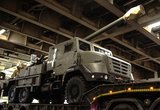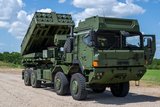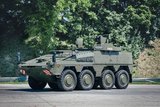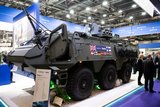Supacat Protected Vehicle (SPV) 400 contender for UK MoD LPPV programme unveiled
The Supacat Protected Vehicle (SPV400) today received its International Media Launch at the Long Valley Test Ground, Aldershot, UK. The SPV400 is the contender from British high mobility vehicle specialist, Supacat, for the UK Ministry of Defence's Light Protected Patrol Vehicle (LPPV) programme. Under an Urgent Operational Requirement the UK MoD is expected to order an initial batch of 200 vehicles to enter service in early 2011.
The all-new, all-British SPV400 will give British troops the protection and mobility they need against the threat from Improvised Explosive Devices (IEDs) on operations in Afghanistan. It combines an integrated blast and ballistic protection system, including all composite protected crew pod and V-shaped hull, with exceptional cross country mobility and the agility to manoeuvre in tight urban environments.
"The SPV400 is purpose designed for LPPV and offers a 21 century solution for 21st century operations. Its clean sheet design is `future-proofed` and can be upgraded to exceed the present LPPV requirements for protection and mobility", said Nick Ames, Managing Director of Supacat Ltd.
The SPV400 is designed by Devon based Supacat, the world leader in high mobility, all terrain vehicles. Its armour protection partner is Coventry based NP Aerospace, which has designed the composite crew pod and protection system with access to the UK's classified armour technology. Supacat and NP Aerospace have formalised their Alliance Agreement under which volume production will be conducted through the Alliance at NP Aerospace's Coventry facility.
Supacat and NP Aerospace have proven track records in supplying and supporting vehicles in service with British Forces in Afghanistan, with Supacat responsible for Jackal and Coyote and NP Aerospace for Mastiff and Ridgback.
With the Design Authority for the SPV400 being UK based, all Intellectual Property Rights for the SPV400 automotive and protection systems reside with Supacat and NP Aerospace. This means the UK retains full control over future design upgrades and the SPV400 is free from US ITAR restrictions.
The selection of the SPV400 for LPPV would strengthen the UK's innovation and engineering skills base, support manufacturing jobs and ensure potential export revenues are retained in the UK. The SPV400 bid will sustain and protect between 1000 and 1200 jobs throughout the UK.
"The UK MoD's selection of a vehicle for the LPPV programme is being closely followed by several countries, underlining the considerable export potential for a vehicle in this class", said Nick Ames.
Source: Supacat
More from Land Warfare
-
![Lockheed Martin to look further afield for GMARS rocket system opportunities]()
Lockheed Martin to look further afield for GMARS rocket system opportunities
The HX truck is already in use in many NATO and allied countries around the world as a logistics vehicle and carrier for high-value systems, including missile firing weapons, so its use for the Global Mobile Artillery Rocket System makes logistical sense.
-
![Beyond Survivability: How Active Protection Systems Are Empowering Commanders (Podcast)]()
Beyond Survivability: How Active Protection Systems Are Empowering Commanders (Podcast)
As threats diversify and intensify, APS are proving essential not just for vehicle protection but also for enhancing operational freedom, effectiveness and mission success in contested environments.
-
Medium knocked out of British Army LMP, with CAVS as heavyweight champion
As the British Army seeks to modernise and consolidate its diverse vehicle fleet, yet another change in direction is underway.






















